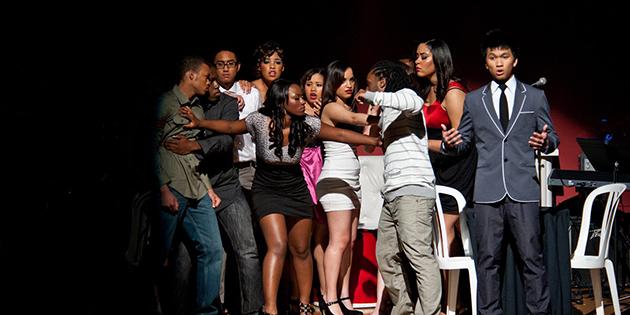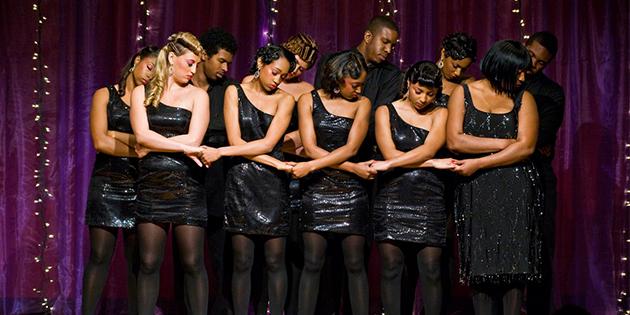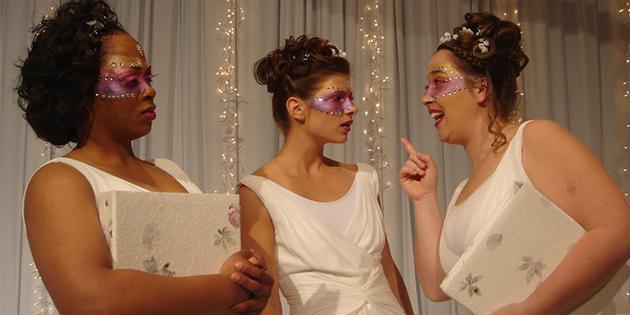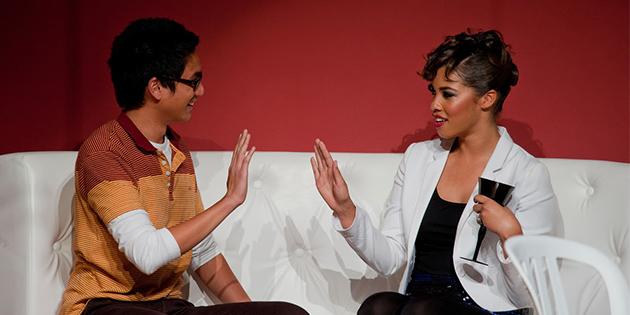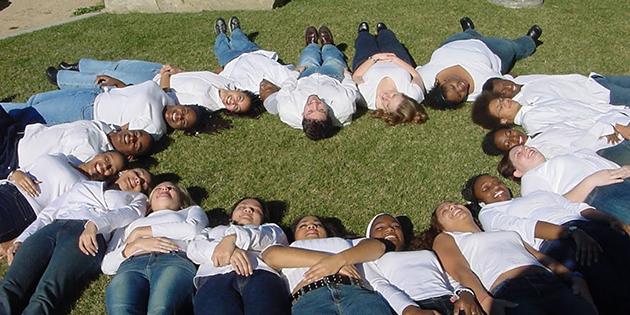MTP Theatrical Profile
MTP's Theatrical Productions
MTP's culminating productions are featured at Seaver College in a theatrical space on campus for the community.
Let’s Talk About Love (Spring 2015)
They cannot define beautiful to me. Someone else's eyes don't see what I see. Follow like I'm blind just won't do for me. God made me just fine. That's why I go to be ... I n I.
—"I N I," Amel Larrieux (song lyric)
Synopsis:
"Let's Talk About Love" explores the complexity of "romantic relationships" and "being single." The evening features artistic expression that examines the notion of "healthy" love, self-love, and friendship connections, romantic or otherwise. This Valentine's Day event features student "Sound Off" short-film vignettes and special guest performers: singer-songwriter and recording artist Amel Larrieux, actor Jason George (of Grey's Anatomy), and spoken word artist Dr. Javon Johnson.
Lift Every Voice (Spring 2014)
Synopsis:
"Lift Every Voice" celebrates the 50th anniversary of the March on Washington and Martin Luther King, Jr.'s, "I Have a Dream Speech"—its historical significance and contemporary exhortation. The evening explores the powerful way in which art challenges our self-understanding, especially as it relates to difference, embodying powerful rhetorical imaginary that reflects and/or refracts the way we move and see ourselves in the world. The show features students and guest performances from various artistic fields: members of the Underground Street Dance crew and Krump pioneers, Marquisa "Miss Prissy" Gardner and Christopher "Worm" Lewis; professor and spoken word artist of Fiveology, Dr. Javon Johnson; professor and visual artist,
Dr. James Noel; professor and systematic theologian, Dr. Raymond Carr; professor and rhetorician, Dr. David Holmes; and Grammy Award-winning actor/singer-songwriter, Dawnn Lewis, as narrator
The action takes place center stage. It begins as the narrator takes the stage, asking the audience, "Have you seen freedom?"
Liberté (Spring 2013)
Every man [and woman] must ultimately confront the question "who am I?" and seek to answer it honestly.
—Martin Luther King, Jr. (1991, p. 588)
Synopsis:
The production explores the complexities of personal identity through poetry, spoken word, rap, short films, dramatic monologues, and nonfiction prose, featuring students and guest performances by Yvette Devereaux (violinist), Erica Powell (harpist), Darrell Harris (percussionist), and Tony Award and Obie Award–winning actress L. Scott Caldwell, as narrator.
The action takes place center stage. It begins with the narrator taking center stage announcing, "Today we are going to take a journey."
Love is … Candie’s Café (Spring 2011, Part II)
Synopsis:
This production is a more complex version of the first production staged in 2002, featuring a new script with new characters based on the same major premise. Set in Los Angeles, California. The story revolves around this new "hip" place where college-age students and recent graduates network. The regulars begin to develop close friendships and a communal bond. In the midst of summer fun, two couples emerge; each couple is confronted with social pressure that causes tension in their relationships. One couple struggles with social-economic class issues and the other couple struggles with their interracial relationship. The show incorporates spoken word, rap, poetry, vocal performance, and musical selections that echo the subtext of the play. The show examines how family systems and personal relationships shape values and behavior while also exploring the complexity of love and acceptance.
The action takes place in Candie's Café over a period of nine months. It begins at the end of the narrative in the midst of a fight and then freezes in time. The narrator, a character in the scene, steps out of the action, breaking the fourth wall, and begins to bring the audience up to date on the events they are witnessing. The narrator stops mid-sentence and decides to show them what happened instead. The action begins in Candie's Café in June one early morning.
The Jazz Age, a musical (Spring 2010)
Besides,/They'll see how beautiful I am/And be ashamed—
—"I, Too," Langston Hughes (2002, p. 253)
When she abandoned herself a little whispered word escaped her slightly parted lips. She said it over and over under her breath: "free, free, free!"
—"The Story of an Hour," Kate Chopin (1969, p. 353)
At certain times I have no race. I am me. When I set my hat at a certain angle and saunter down Seventh Avenue, Harlem City, feeling ... snooty. ... It merely astonishes me. How can any deny themselves the pleasure of my company? It's beyond me.
—"How It Feels to Be Colored Me," Zora Neale Hurston (1979, p. 154)
Synopsis:
The production explores the complexity of one of America's most dynamic decades, the birth of modern America, the 1920s—when people were exploring their individuality and newfound freedom from the world of fashion to religion and world politics, when the pull of big-city living with automobiles and modern conveniences made America and the world a much smaller place. The decade is explored through Bessie Smith's eyes as she shares the highs and lows of the advent of blues, jazz, and the burgeoning black renaissance. As she reflects on figures of the period, they appear to tell their stories: Ma Rainey, Oscar Michaeux, W.C. Handy, Zelda Fitzgerald, Josephine Baker, Marion Anderson, Greta Garbo, Bessie Coleman, Duke Ellington, Louis Armstrong, Zora Neale Hurston, and Langston Hughes.
The action takes place center stage. It begins as Bessie Smith begins to sing and hum the melody of one of her hit songs.
Everything About Love, a poetry recitation (Spring 2008)
Synopsis:
An evening of poems wholly devoted to the multidimensionality of love: familial, phileo, eros, and agápē.
The action takes place center stage.
Once Upon a Time (2006)
Once upon a time there was a sweet little maiden. Whoever laid eyes upon her could not help but love her.
—"Little Red Cap," The Brothers Grimm (2013, p. 159)
He chose the role of purveyor of comforting myths.
—An Image of Africa, Chinua Achebe (1977, p. 4)
Synopsis:
Set in 2006, in an austere, fantastical space. Eight unsuspecting Chicago citizens wake up and find themselves in an unfamiliar and mysterious place. As strangers, they band together to uncover why they found themselves in this place without a clear way to escape. Believing they are being held captive, they plead with their assumed captor who might be listening. In the space, they discover ornate books with their names written on them. The books are filled with fairy tales. Each book contains specific selections that resonate with each respective personal life. As they read aloud, they begin to share their lives and to examine the fairy tales. By the time they reach the end of the books, they have lost track of time and feel a sense of connection to each other. Each individual is resolved to live differently, with the hopes of seeing the others again. Without warning, as they begin to embrace each other, they each disappear as mysteriously as they appeared. This production explores the nature of fairy tales, evaluating how their mythology influences our lives, self-perceptions, gender constructs, notions of intimacy and romance, and conceptions of justice. This production raises important questions about self-love and acceptance.
The action takes place over one hour in this peculiar space. It begins with Isabella waking up confused. As she rises and begins to steps back—perusing her surroundings—she bumps into someone and is startled and shouts, "Who are you?"
Jubilee: A Celebration of Gospel Music (Spring 2005)
Images of life between joy and sorrow, conversion images, oppression, deliverance and hope, heaven. No matter what the day would bring many slaves took solace in I Am that I Am.
—Narrator (in production)
Synopsis:
The evening tells the story of gospel music, from spirituals to hip-hop gospel interwoven with the historical context of each respective period in African American history. The narrator functions as a griot giving shape to the wisdom and values each medley evokes. The evening culminates with Pepperdine/MTP alumni sharing reflective moments of their experience in the MTP.
The evening begins as the ensemble enters from the back of the auditorium, down the center aisles, singing "Amen."
Motown and the Sixties, a musical (Spring 2004)
I didn't know much about the South at all but over the years I've heard many stories about our family history. ... Pop loved to tell us his own stories about his origins. ... The son of Esther Johnson, a slave woman, and her white plantation owner, that little mulatto boy was Pop's father, my grandfather—the first Berry Gordy. Once freed, Esther Johnson left the plantation taking her young son, Berry, with her. ... He acquired 168 acres of his own land, married Lucy Hellum and together they had twenty-three children. Only nine lived. One of them was my father, Pop—the second Berry Gordy.
—To Be Loved, Berry Gordy (1994, pp. 11–12)
I think ... that this is not much of a democracy if you ask me. Equal chance to pursue happiness means an equal crack at the dough, don't it?
—"The Lesson," Toni Cade Bambara (1972, p. 95)
Synopsis:
Set in 1988, Los Angeles, California. This collage of the decade explores the sociocultural (or countercultural) and political features of the decade contextualized by oral history in tandem with the story of Motown and its founder, Berry Gordy. His story explores his slave heritage, humble beginnings, and rise at the peak of national turmoil to affluence as the largest black-owned business in the United States. As Gordy shares his story, he reminisces on significant aspects of this tumultuous time.
The action takes place over the span of one hour in Berry Gordy's office as he packs his belongings after selling his share in the company. It begins with Gordy standing over a box at his desk looking at a photo.
Voice! (Spring 2003)
Not a flat. Not an apartment in back. Not a man's house. Not a daddy's. A house all my own. With my porch and my pillow, my pretty purple petunias. My books and my stories. My two shoes waiting beside the bed. Nobody to shake a stick at. Nobody's garbage to pick up after. Only a house quiet as snow, a space for myself to go, clean as paper before the poem.
—The House on Mango Street, Sandra Cisneros (1991, p. 108)
If de fust woman God ever made was strong enough to turn the world upside down, all 'lone, dese togedder, ought to be able to turn it back and get it right side up again ...
—"Ain't I a Woman," Sojourner Truth (1970, p. 106)
Synopsis:
The production is a collection of short stories and poems by women writers. The structure of the play places these texts in dialogue with each other creating a collage; the complexity of "intersectionality" of women's issues emerges (Crenshaw, 1989). The narrative progression begins with childhood and progresses through adolescence to adulthood. The first act explores how girls are socialized to see themselves from a gendered perspective. This section explores the dynamics of class and its effect on adolescent young women. Act II explores the beauty myth and the destructive nature of this discourse if left unchecked and/or internalized. Act III discusses the role of women in society (particularly the roles of wife and mother). Finally, Act IV celebrates women—real women who have succeeded against these deleterious social forces.
The action takes place center stage for each montage.
A Different Mirror (Fall 2002)
Let our history help you to fulfill yours.
—Maria W. Stewart, historical figure (character in the play)
Synopsis:
Set in the present day, San Diego, California. This production explores teaching as vocation and is inspired by and features four personal narratives of historical women: Ann Pointer, Jean Park, Julia A. J. Foote, and Maria W. Stewart. Their stories are woven into a fictive narrative about one young woman's struggle with her desire to teach after learning about these historical women's lives. In A Different Mirror: A History of Multicultural America, Ronald Takaki (1993) asked, "Will Americans of diverse races and ethnicities be able to connect themselves to a larger narrative? Whatever happens, we can be certain that much of our society's future will be influenced by which 'mirror' we choose to see ourselves."
Melissa finds some old photos and documents that belonged to her grandmother, who recently died in a car accident. She takes home the documents and artifacts she finds in her grandmother's attic with an old trunk. She discovers that the trunk is full of historical information about four women and becomes engrossed. She begins to read her mother's journal and the narratives about these women. This experience causes her to reevaluate her "career" decision. From the journal, she learns that her mother stopped teaching because she felt the academy was not inclusive (her grandmother
began teaching in the late 1960s). As Melissa reads portions of the historical women's biographies, this action summons their appearance in her home.
The women do not understand why they appear together from different eras in Melissa's apartment (Melissa cannot see or hear them). They begin to speak to each other and share common experiences. By the evening, after hearing Melissa share her ambivalence about teaching with her friend who drops in to see her, the historical women understand their purpose in her home. As she continues to read, the women's presence in her home fills Melissa with hopefulness, and despite her fear and frustration, she decides she will teach.
The story emphasizes the deep connection we all have to one another in the stream of history and how each life impacts a greater community, focusing on teaching as a vocation (see sample script excerpts in Chapter 8).
The action takes place over seven hours in Melissa's apartment living room. It begins with a knock at the door.
Love is … Candie’s Café (Spring 2002, Part I)
Synopsis:
Set in Los Angeles, California. The story revolves around this new "hip" place where college-age students and recent graduates network. The regulars begin to develop close friendships and a communal bond. In the midst of summer fun, two couples emerge; the couples are confronted with social pressure that causes tension in their relationships. One couple struggles with social-economic class issues and the other couple struggles with the interracial aspect of their relationship. However, unbeknownst to anyone in the café, angels are present, encouraging and promoting love and healing. The show incorporates vocal performance, poetry, and musical selections that echo the subtext of the play. The show examines how family systems and personal relationships shape values and behavior while also exploring the complexity of love and acceptance.
The action takes place in Candie's Café over a period of nine months. It begins at the end of the narrative in the midst of a fight and then freezes in time. The narrator, a character in the scene, steps out of the action, breaking the fourth wall, and begins to bring the audience up to date on the events they are witnessing. The narrator stops mid-sentence and decides to show the audience what happened instead. The action begins in Candie's Café in June one early Saturday morning.
Who Do You Think I Am? (Fall 2001)
I wish people would think that I am a real Mexican. I am proud of my heritage. I may not carry all of the cultural signifiers but I am a real Mexican.
—Brenda (character in the play)
Synopsis:
Set in Los Angeles, California, midcity area, at a theatre company. A young woman attends a summer theatre workshop and is rejected for a part in the final production because she is African American. All of the members of the summer workshop arrive competitively, prejudging one another based on the initial audition meeting. Unexpectedly, however, by the end of the summer, they find themselves a close-knit group that survived their oppressive and controlling theatrical workshop coach. The show presents the "reality" of each character's life privately in juxtaposition with how each character presents himself or herself publicly. This relational dynamic is played out within the fictive narrative.
The action takes place over three months in the theatre rehearsal stage and break room. It begins on the theatre rehearsal stage, with each hopeful actor auditioning for a spot in the summer workshop.
Harlem Renaissance Culture (Spring 2001)
Synopsis:
Set in 1930s Harlem. The production is derived from 50 Works Progress Administration (WPA) recordings collected between 1934 and 1939. The oral histories and short fictions capture the African American experience in Harlem during the Renaissance and Great Depression. The narratives provide an authentic look at the day-to-day social-economic and racist reality of the time. The personal stories challenge the normative view, revealing that two Harlems existed: the exotic space for black aesthetic and cultural consumption in juxtaposition with the daily grind of eking out a living during such flamboyant times.
The action takes place on a street in Harlem. It begins with a street vendor telling his story.
The Piano Lesson by August Wilson (Spring 2000)
Synopsis:
Set in Pittsburgh, 1936. The Charles family is embattled over a family member's (Boy Willie) desire to sell a cherished family heirloom retrieved after slavery ended, a piano that once was traded for Doaker Charles' grandmother and father by their slave owner, Sutter, to give to his wife. Doaker's brother, Boy Charles, was killed after successfully stealing the piano from the Sutter family.
The action takes place center stage as a staged reading.
